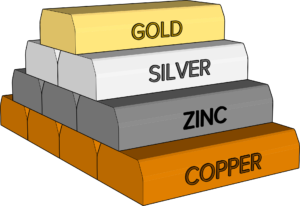
Many of the mining studies that I have worked on were deposits containing multiple recoverable metals. For example this might be Ag-Pb-Zn mineralization or Cu-Pb-Zn-Au-Ag mineralization. Discussions were held regarding whether to use a “metal-equivalent grade” to quantify the deposit grade or to use a Net Smelter Return (“NSR”) dollar value.
This also becomes an issue since one must decide how to apply a cut-off grade for mine planning and reporting. It can be applied to the major metal grade only, to the equivalent grade, or to an NSR dollar value.
The NSR represents a $/tonne recovered
I have found that the geologists tend to prefer using a metal-equivalent grade approach. This is likely due to the simpler logic and calculation required for an equivalent grade formula. At an early stage it’s also simpler to select a reporting cutoff grade based on similar projects.
 Generally I have no major concerns with the metal-equivalent approach at the resource estimate stage. However from an engineer’s view, an equivalent grade does not provide a meaningful representation of the ore quality.
Generally I have no major concerns with the metal-equivalent approach at the resource estimate stage. However from an engineer’s view, an equivalent grade does not provide a meaningful representation of the ore quality.
It is more difficult to relate an equivalent grade to an operating scenario that may rely on different mining or processing methods generating different final products (e.g. dore versus concentrates). The NSR approach makes it easier to understand the actual quality of the ore.
On the downside, the NSR calculation will require more input data. Assumptions needed relate to metallurgical recoveries, concentrate characteristics and costs, and smelter payables. However the end result is an NSR block value that can be related directly to the site operating costs.
For example if a certain ore type has an on-site processing cost of $20/tonne and G&A cost of $5/tonne, then in order to breakeven the ore block NSR value must exceed $25/tonne. If one decides to include mining costs and sustaining capital costs, then the NSR cutoff value would be higher. In all cases one can directly relate the ore block value to the operating cost and use that to determine if it is ore or waste. This is more difficult to do using equivalent grades.
Where the equivalent grade can become a problem is when one cosiders the impact of metal prices. For example, the rock grades can be aggregated to, say, an Ag- equivalent. However this does not mean that if the silver price goes up by 20% that the rock value also goes up by 20%. The other metal prices may not have changed, and hence only the equivalent formula would change. The rock value would go up, but not by 20%.
Using the NSR approach, the operating margin per block is evident.
One drawback to the NSR block value approach is that the calculation will be based on specific metal prices. If one changes the metal prices, then one must recalculate all of the NSR block values and re-populate the model.
In some studies, I have seen higher metal prices used for resource reporting and then lower metal prices for mine planning or reserves. In such cases, one can generate two different NSR values for each block. One can use the same NSR cutoff value for reporting tonnages. This two NSR approach is reasonable in my view since Resources and Reserves are different entities.
Pit Optimization



How do you relate equivalent grade to cutoff grade when deciding to mine a block on a daily basis?.
It seems that the equivalent ore grade is suitable for the pre and feasibility stage of a mining project.
I generally prefer the use of NSR$ values than equivalent grade, however one can still use equivalent grade. The equivalent grade is based on a ratio of metal prices so may not change much day to day but could change monthly. For example if gold price is high and silver is low, then silver grade might not add much revenue so mining may avoid some material with moderate silver content. Now if the silver prices increase, those moderate silver grades may now generate more revenue so that same material would now become interesting. So what you decide to send to the mill will depends on what the current metal prices are and not just what was used in the feasibility study.
Ken – I completely agree that NSR is far superior to equivalent grade. However, when it comes to mineral resource reporting I have had negative feedback from securities reviewers on using the term NSR outside of a feasibility study. I usually have to call it something else like ‘recoverable metal value’ to be acceptable.
Thus far I have not gotten negative feedback when using NSR in a PEA, but that’s not to say others haven’t. For an early stage resource tech report, I agree using the NSR is a stretch given the limited met data that may be on hand.